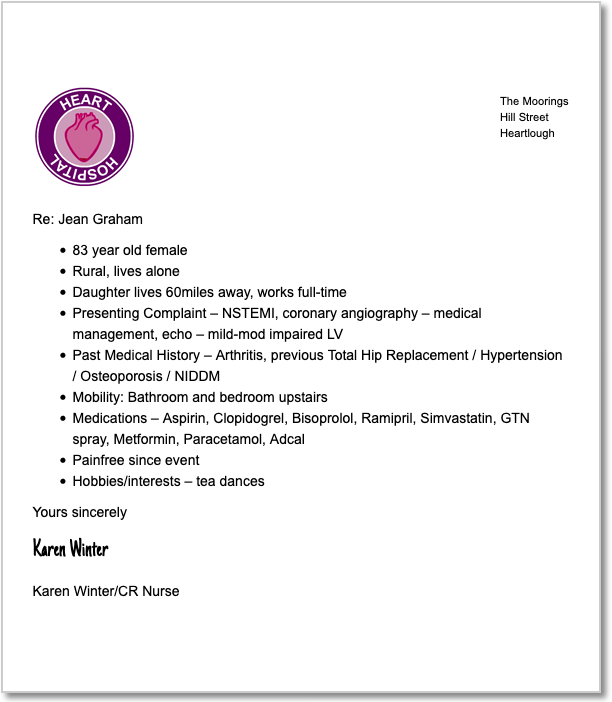This is the referral letter from hospital Cardiac Rehabilitation (CR) team to community CR nurse:

The Moorings
Hill Street
Heartlough
Re: Jean Graham
- 83 year old female
- Rural, lives alone
- Daughter lives 60miles away, works full-time
- Presenting Complaint – NSTEMI, coronary angiography – medical management, echo – mild-mod impaired LV
- Past Medical History – Arthritis, previous Total Hip Replacement / Hypertension / Osteoporosis / NIDDM
- Mobility: Bathroom and bedroom upstairs
- Medications – Aspirin, Clopidogrel, Bisoprolol, Ramipril, Simvastatin, GTN spray, Metformin, Paracetamol, Adcal
- Painfree since event
- Hobbies/interests – tea dances
Yours sincerely
Karen Winter
Karen Winter/CR Nurse
Pulse point
British Association for Cardiovascular Prevention Rehabilitation: Standards & Core Components
The patient pathway within each area will vary. If you are unsure, contact your local network. The Department of Health Commissioning Pack for Cardiac Rehabilitation details a recommended seven stage (0-6) pathway of care from patient presentation (e.g. diagnosis or cardiac event), identification for eligibility, referral, and assessment through to long-term management. Whilst intended for England, this pathway of care is relevant to all four nations. Each of these stages within this process is vital for programme uptake and adherence, the achievement of meaningful clinical outcomes and ensuring longer-term behaviour change and desired health outcomes. The assessed information must also be managed in a manner to fulfil the need for audit and evaluation. It is important to recognise that care across this seven stage pathway may involve different healthcare settings and organisations. In the case of tertiary services, the repatriation of patients results in this pathway being more complex. In these instances there is a responsibility of the service provider on the completion of any stage to effectively communicate the patient’s clinical status and individual needs prior to their transfer of care.
Page last reviewed: 27 Jul 2020


